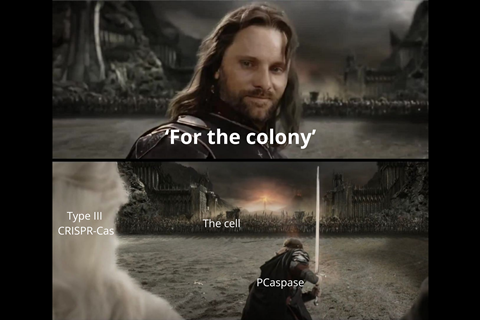
Wageningen researchers describe in Science how type III CRISPR-Cas systems activate a cascade of reactions that causes an infected bacterium to die, but the rest of the colony to survive. ‘You could call it an altruistic act.’
CRISPR-Cas9 first came to prominence a few years ago as a cut-and-paste tool for DNA. Since then, many other CRISPR-Cas variants have been found, almost all of which do the same thing: cut foreign DNA. But there is one exception: type III CRISPR-Cas from the bacterium Haliangium ochraceum cuts mainly RNA. This makes the system special and strange’, says Raymond Staals, associate professor at Wageningen University. Cutting RNA to defend itself is actually pretty stupid, because viruses can just make new RNA from the original DNA. Nevertheless, it works and it took us a long time to understand why.
Staals has been studying the type III system since 2011, and around 2018 it became clear that the system not only cuts RNA, but also makes certain signalling molecules. ‘Cutting RNA also releases a number of signalling molecules’, Staals continues. ‘This has been known for some time, but our work shows that these signalling molecules trigger a cascade of reactions similar to apoptosis. And that could be of interest in the future.’
Destroyer of Worlds
Before speculating about applications, it is useful to know exactly how this cascade of reactions works. It starts, as mentioned, with the cutting of RNA. Staals explains: ‘The CRISPR-Cas system then produces signalling molecules, including cyclic triadenosine monophosphate [cA3, ed]. These then activate a protein domain responsible for switching enzyme activity on and off, called the SAVED or CARF domain. The protein we studied, SAVED-CHAT, also binds these signalling molecules. The result was that multiple SAVED-CHAT filaments start to stick together.’
The stacked SAVED-CHAT filaments form a structure that Staals and his colleagues had never seen before. ‘Similar to DNA strands, opposite filaments stick together; it becomes a kind of DNA of proteins.’ In turn, the filaments induce SAVED-CHAT to become an active protease (protein cutter). We thought that was it, but that was not the end of the story: SAVED-CHAT specifically cuts only one protein, which we called PCaspase. PCaspase then also becomes a protease, and it goes haywire and chops everything up. So we nicknamed it the “Destroyer of Worlds” because that is what ultimately kills the cell.’ Of course, the bacterium itself does not benefit from this, but it sacrifices itself to save the population. ‘You could call it an altruistic act.’
Type III versus apoptosis
This stacking of protease activations is conceptually identical to how apoptosis (programmed cell death) works in eukaryotic cells, Staals explains. ‘Apoptosis also works to eliminate cancer cells, so we are very cautiously looking to see if the same could be done with this cascade. The biggest obstacle is that type III CRISPR-Cas is a bit more complicated than Cas9. CRISPR-Cas9 lets one protein do all the work, but type III involves six proteins and two proteases. Eight proteins in total, and therefore eight genes, which makes it more cumbersome. It would help if we could make the cascade a single-protein system, but that is a long way off and not the only obstacle.’
What is already possible with this system is diagnostics. Staals: ‘When type III encounters a single piece of RNA, it makes several signal molecules, a large signal amplification. With Cas9 there is only one event, with type III there are thousands. This system does something that no other Cas system does.’ Staals and his colleagues, including first author Jurre Steens and co-author Stijn Prinsen, have already incorporated this idea into a spin-off company, Scope Biosciences. ‘They provide the diagnostic assays and the generation of a fluorescent signal. We just need to link the type III proteases to the existing technology developed by Scope Biosciences and then our diagnostic tool is complete.’
Finally, Staals adds that he likes the fact that they have been able to publish the complete cascade. ‘I particularly like the chain reaction. A lot of groups choose to publish this kind of research in pieces, but I prefer to wait a little longer to write down a story like this in its entirety.’
Steens, J.A., Bravo, J.P.K., Salazar, C.R.P., et al. (2024) Science 383(6682), DOI: 10.1126/science.adk0378












Nog geen opmerkingen